Case Study: Restoring a Vehicle to Its Pre-Accident Condition
ss
Introduction to Vehicle Restoration
Accidents are an unfortunate reality of driving, and they often leave vehicles in less than optimal condition. The process of restoring a vehicle to its pre-accident state involves a meticulous combination of skilled craftsmanship, advanced technology, and quality materials. In this case study, we explore the journey of a vehicle from being damaged in an accident to being restored to its original glory.

Initial Assessment and Damage Evaluation
The first step in the restoration process is a thorough assessment of the damage. This evaluation is crucial as it determines the extent of repairs needed. Technicians inspect the vehicle both visually and with diagnostic tools to identify all affected areas. Understanding the full scope of damage ensures that no issue goes unnoticed, leading to a comprehensive repair plan.
During this stage, the technician documents every detail, from minor scratches to major structural damage. This documentation helps in creating an accurate estimate and timeline for the restoration process.
Crafting a Detailed Repair Plan
Once the assessment is complete, a detailed repair plan is developed. This plan outlines each step necessary to return the vehicle to its pre-accident condition. It includes:
- Ordering replacement parts
- Scheduling necessary labor
- Coordinating with insurance providers for claims processing

The Restoration Process
With the plan in place, the restoration work begins. This phase involves several key stages:
- Dismantling: The damaged portions of the vehicle are carefully dismantled to prepare for repair or replacement.
- Body Repair: Skilled technicians work on reshaping and replacing body panels, ensuring that all components align perfectly.
- Paintwork: A high-quality paint job is essential to restore the vehicle's original appearance. Color matching is done meticulously to ensure uniformity.
Throughout this process, attention to detail is paramount. Every bolt and panel is checked for proper alignment and fit.

Quality Control and Final Inspection
Before handing the vehicle back to its owner, it undergoes a rigorous quality control inspection. This step ensures that all repairs meet industry standards and the vehicle is safe to drive. Technicians double-check each repair point, ensuring no aspect of the restoration is overlooked.
The final inspection also includes a road test to verify that the vehicle performs as expected in real-world conditions. This comprehensive check guarantees that the restoration has been successful.
Customer Satisfaction and Delivery
Once the vehicle passes the quality control phase, it is ready for delivery. The moment a customer sees their restored vehicle is incredibly rewarding. Seeing their car returned to pristine condition provides peace of mind and satisfaction.
The positive feedback from customers highlights the importance of thorough restoration work. It reinforces the commitment to excellence that drives every step of the process, from initial assessment to final delivery.

Conclusion
Restoring a vehicle to its pre-accident condition is a complex yet fulfilling task that requires expertise, precision, and dedication. This case study underscores the importance of each phase in the restoration journey, ensuring vehicles not only look great but are safe and reliable once again. By adhering to high standards and employing skilled professionals, a seamless restoration process becomes possible, bringing cars back to life one repair at a time.